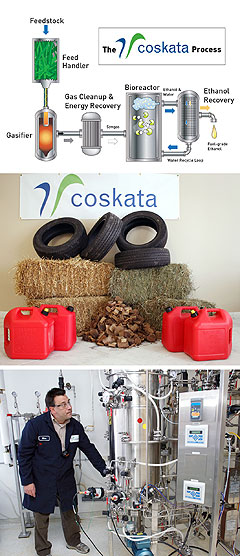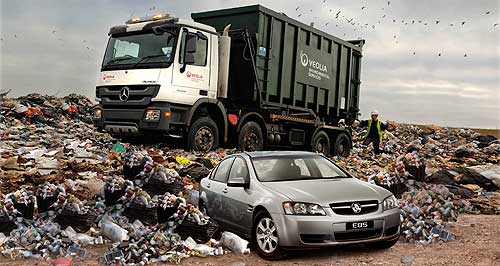Make / Model Search
News - HoldenHolden steps up ethanol-from-trash pushWaste not: Holden's new E85 Commodore is set to run on ethanol, including fuel made in Victoria from rubbish. Victorian ethanol plant and expanded E85 network to power new flex-fuel Holdens23 Mar 2010 GM HOLDEN has made a bold move to become a leader in ethanol-fuelled vehicles in Australia, revealing details of a plan to join forces with the Victorian government, US bio-fuels leader Coskata, Caltex, Veolia Environmental Services and other partners to develop Australia’s first plant to make ethanol from garbage. Melbourne is the likely site for the plant, which will use GM partner Coskata’s ground-breaking technology to produce more than 200 million litres of ethanol a year from household rubbish and building waste for E85 automotive fuel – a blend of up to 85 per cent ethanol and 15 per cent petrol. With its E85-ethanol flex-fuel Commodore due to hit the streets this year, Holden and its consortium partners also have committed to establishing a national ethanol fuel network to fuel it. As part of General Motors’ plan to take a “leadership position” on ethanol, Holden confirmed in December 2008 it would produce the E85-compatible Commodore this year, and revealed it was in negotiations with US bio-fuel producer and GM partner Coskata to establish the first cellulostic ethanol facility outside North America. News of the consortium was announced inadvertently on GM’s global media website on Monday (March 22), before an official media announcement by Holden and the Victorian government could be arranged. A joint press conference to announce Holden’s ambitious E85 plan is now expected to take place tomorrow (March 24). Holden says the newly-formed group will investigate the viability of establishing Australia’s first second-generation ethanol plant capable of turning materials such as household rubbish, agricultural and building waste and even old tyres into ethanol. It continues to forecast that ethanol-fuelled vehicles – powered by a dedicated new version of the direct-injection SIDI V6 that debuted in the MY10 Commodore – could replace up to 30 per cent of petrol-powered Commodores. Meantime, Coskata maintains that its renewable ethanol-from-garbage has the potential to reduce lifecycle greenhouse gas emissions by up to 84 per cent compared with regular petrol – without impacting the availability or price of global food crops, thereby eliminating the food-for-fuel controversy that plagues traditional ethanol production. Most of Australia’s ethanol is produced from waste streams of the industrial production of wheat starch, sorghum and molasses, which are derived from grains and sugarcane. In a high-profile promotion for E85, V8 Supercars run on the blend made by Queensland producer CSR.  From top: Coskata's patented ethanol system, some of the materials that ethanol can be made from, and Coskata's trial plant in the US. From top: Coskata's patented ethanol system, some of the materials that ethanol can be made from, and Coskata's trial plant in the US.However, rather than relying on one primary source of feedstock, the Coskata plant being proposed for Victoria will produce ethanol from a variety of sources, including wood biomass, agricultural waste, construction waste and even household garbage, in a process generally referred to as a second-generation ethanol production. “At Coskata, we don’t make fuel from food crops – we use sources like municipal waste that have reached the end of their lifecycle and turn them into renewable energy, which leads to a net positive effect for the environment,” says Coskata’s chief marketing officer Wes Bolsen. At the same time, Holden and Caltex have announced an agreement to install E85 pumps in 30 metropolitan and regional service stations by July 1, 2010, increasing to 100 by July 2011. So far only a handful of pumps around Australia offer the ethanol-blended alternative fuel commonly known as E85, which is a mixture of up to 85 per cent ethanol and 15 per cent regular petrol – unlike the commonly available E10, which is only 10 per cent ethanol. Former GM subsidiary Saab was a pioneer of E85-capable new vehicles in Australia and since GM and Holden announced their ethanol push Volvo and even Bentley have confirmed plans to offer a full range of E85-ready models. GM, which invested heavily in Coskata when it took an undisclosed equity share of the biology-based ethanol producer in January 2008, believes it has the premier technology to rapidly commercialise and distribute ethanol fuel worldwide. Coskata claims it can produce ethanol for less than $US1 per gallon from almost any carbon-containing feedstock, while using only one litre of water for each litre of ethanol produced and returning 7.7 times as much energy as is used in the production process. Ethanol-blended fuel is used in vehicles in Brazil, Sweden and the US, where around eight million flex-fuel vehicles are on the road. GM has already produced more than 3.5 million of them and, along with Ford and Chrysler, has committed to making 50 per cent of its new-model fleet flex-fuel capable by 2012. The number of E85 GM models has expanded from 11 in 2008 to 15 in 2009, while GM this year launches its first four-cylinder E85 model, the Chevrolet HHR FlexFuel. Holden’s energy and environment director Richard Marshall reiterated Holden’s promise to introduce Australia’s first locally produced flex-fuel vehicle, capable of running on the high-ethanol fuel, later this year. “This will add to our broad range of EcoLine vehicles that use alternative fuel or fuel-saving technology, further contributing to Holden’s energy diversity strategy,” he said. Mr Marshall said the organisations in the consortium – which also includes Mitsui – were committed to sustainable motoring through the development of renewable fuels that reduced greenhouse gas emissions and improved energy security. “Our vision is that this breakthrough technology will cut Australia’s dependence on petrol by up to 30 per cent and make a major contribution to sustainable motoring and greenhouse gas reduction,” he said. “We’ve always said we’d take a leadership position on bio-fuels, and provide the vehicles to do that. “We’re committed to having locally built Holden cars capable of running on E85 in the market by 2010. “It’s about designing and engineering vehicles for Australians, built by Australians, using Australian fuel alternatives.” Caltex’s commitment to E85, meantime, represents a turnaround from the Australian petroleum industry’s position in mid-2008, when BP, Mobil and Shell told GoAuto they had no plans to offer E85 fuel at any of their Australian outlets. GM’s former R&D and strategic planning chief Larry Burns, who met with federal industry minister Kim Carr and Victorian premier John brumby to discuss future Holden technologies in August 2008, had previously said that if Australian fuel companies did not get behind a local E85 network Holden would organise independent suppliers to do so. Caltex Australia general manager marketing Andy Walz has now confirmed his company has signed an agreement that will ensure the availability of the fuel for Holden and other vehicles via at least 100 locations by the middle of next year. “Caltex’s expansion into this new fuel and participation in the consortium are part of our ongoing commitment to bio-fuels and climate change, and fit well with a strategy of providing energy beyond the traditional fuel mix,” said Mr Walz. “Caltex already has about 400 service stations that sell E10 and a growing bio-diesel market. We believe the bio-fuels industry has a vital role in a sustainable transport fuels future and that bio-fuels are good business opportunity for Caltex.” Caltex will announce the locations of its capital city and regional E85 retailers within the next three months. Caltex’s Australian E85 fuel will contain between 70 and 85 per cent ethanol – or ethyl alcohol, which is the same type of alcohol found in alcoholic beverages - blended with regular petrol, depending on the time of year. Because ethanol works best in warmer conditions, Caltex will decrease the amount of ethanol in the bio-fuel blend to ensure optimal performance during winter months. Like LPG, E85 is consumed by engines at a higher rate than petrol that is not blended with ethanol, due to ethanol’s higher octane rating. As with E10, E85 is suitable only for vehicles designed specifically for it, but most models can run on any ethanol/petrol combination up to 85/15 per cent. The Victorian group general manager for Veolia Environmental Services, Simon Tori, said E85 consortium’s initiative was a quantum leap from the way in which Victoria currently receives, sort and treats its existing waste. “Deriving energy from municipal, commercial and industrial waste that is otherwise bound for landfill, is an exciting possibility and such a facility will enable Veolia to be at the forefront of the emerging advanced resource recovery treatment sector.”  Read more8th of September 2009  E85: Commodore’s next big thingEthanol cars to replace up to 30% of petrol Commodore sales from late next year30th of March 2009  US ethanol innovator pushes for $300m Oz plantStates vie to establish our first clean ethanol production plant as Holden goes E8528th of January 2009  First look: Bentley's biofuel bruiserBentley promises supercar performance from its first biofuel model16th of December 2008  Volvo ready for E85 in OzSwedish maker stands ready with ethanol model range as 2010 E85 Holdens drive change9th of December 2008  Ethanol Holdens a year awayHolden confirms E85 engines for local models by 2010, and eyes Oz ethanol production |
Click to shareHolden articlesResearch Holden Motor industry news |










Facebook Twitter Instagram